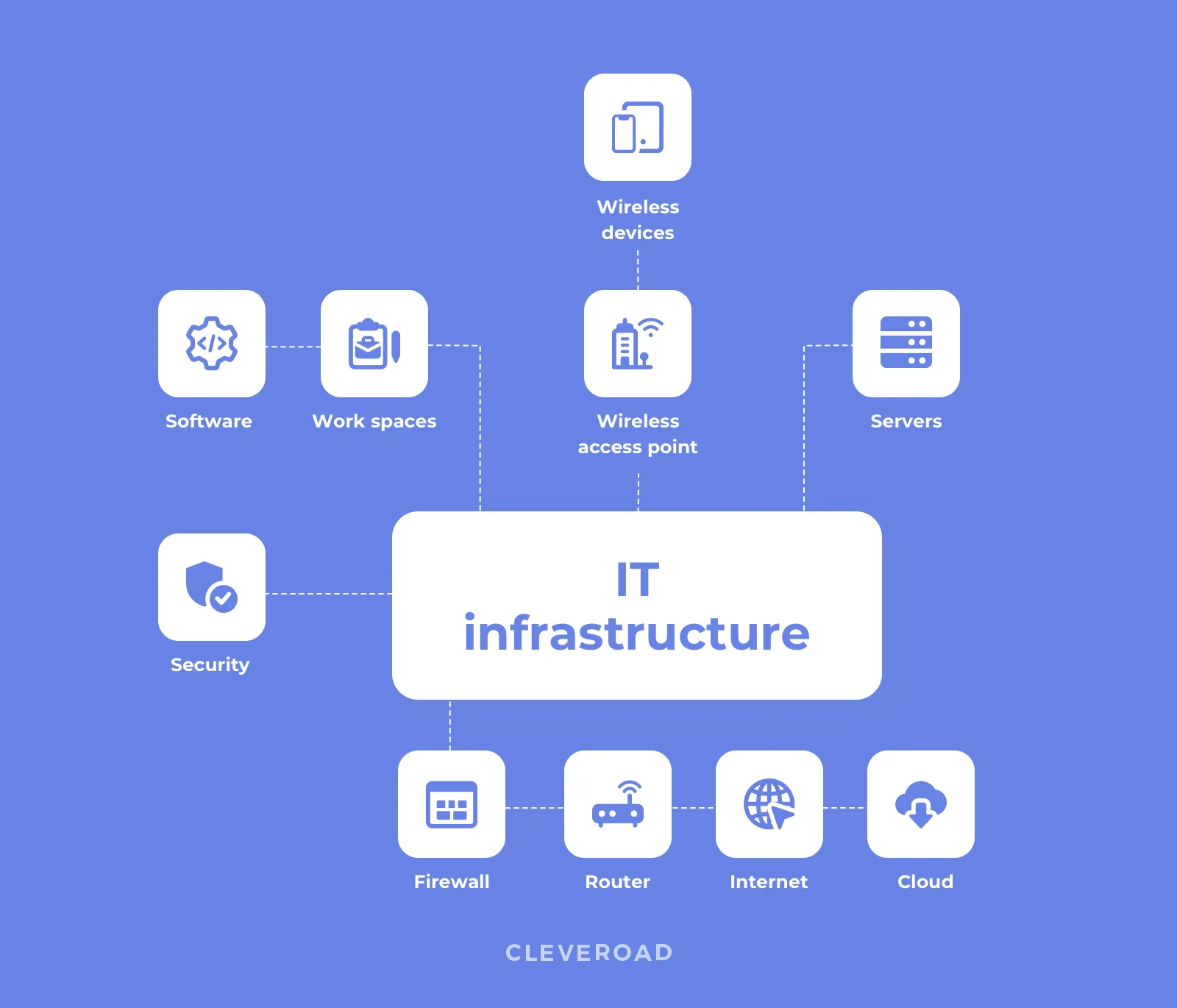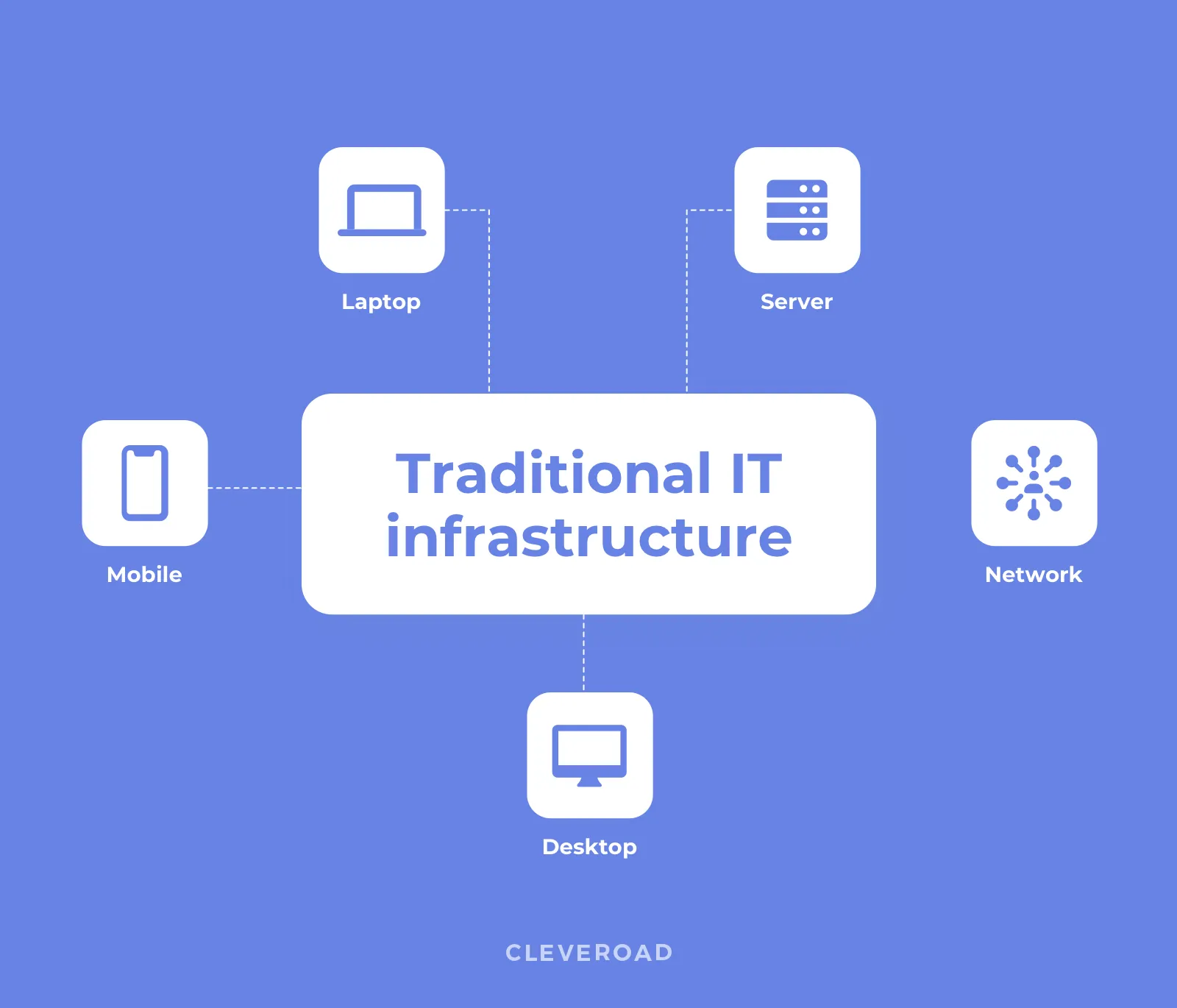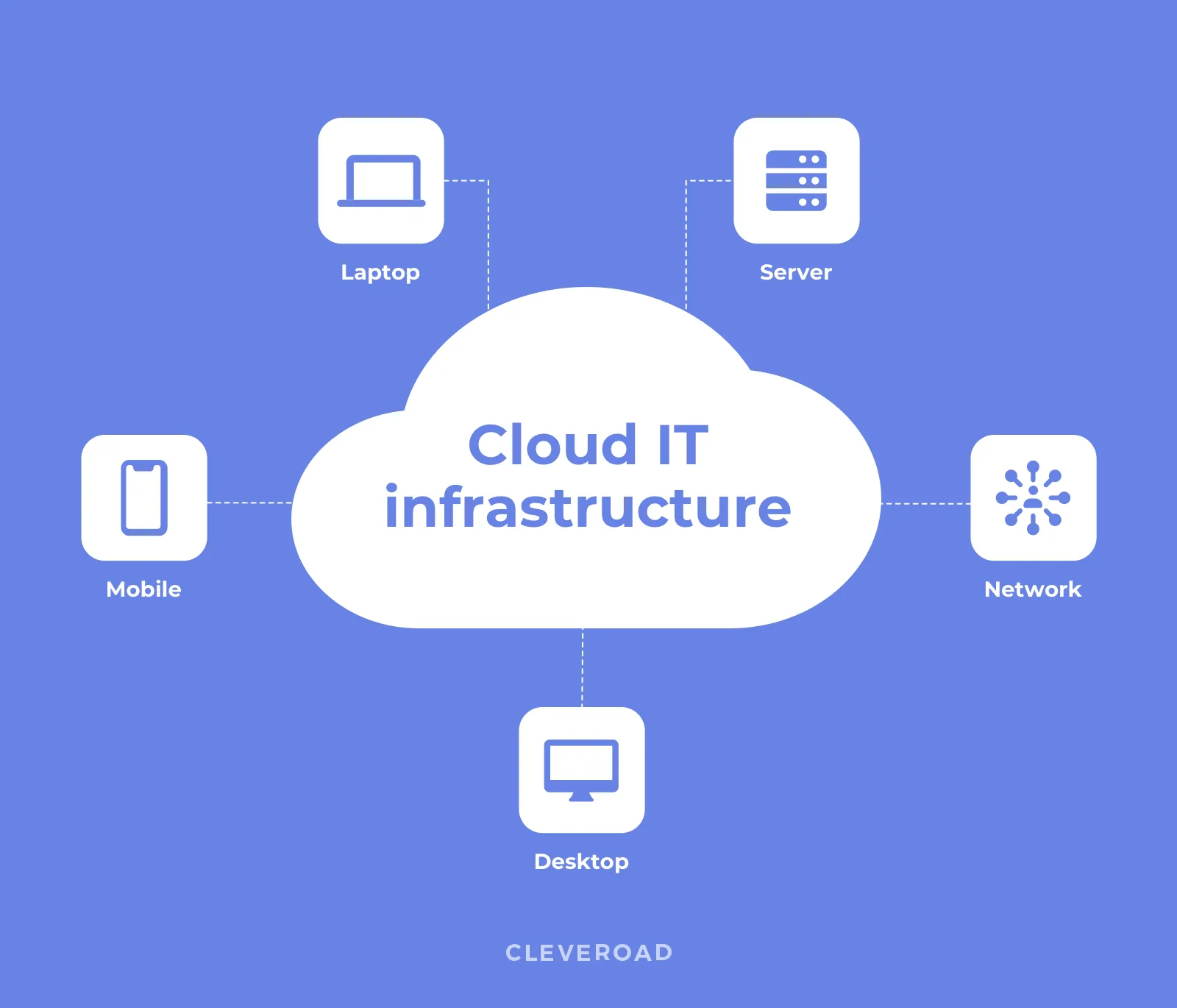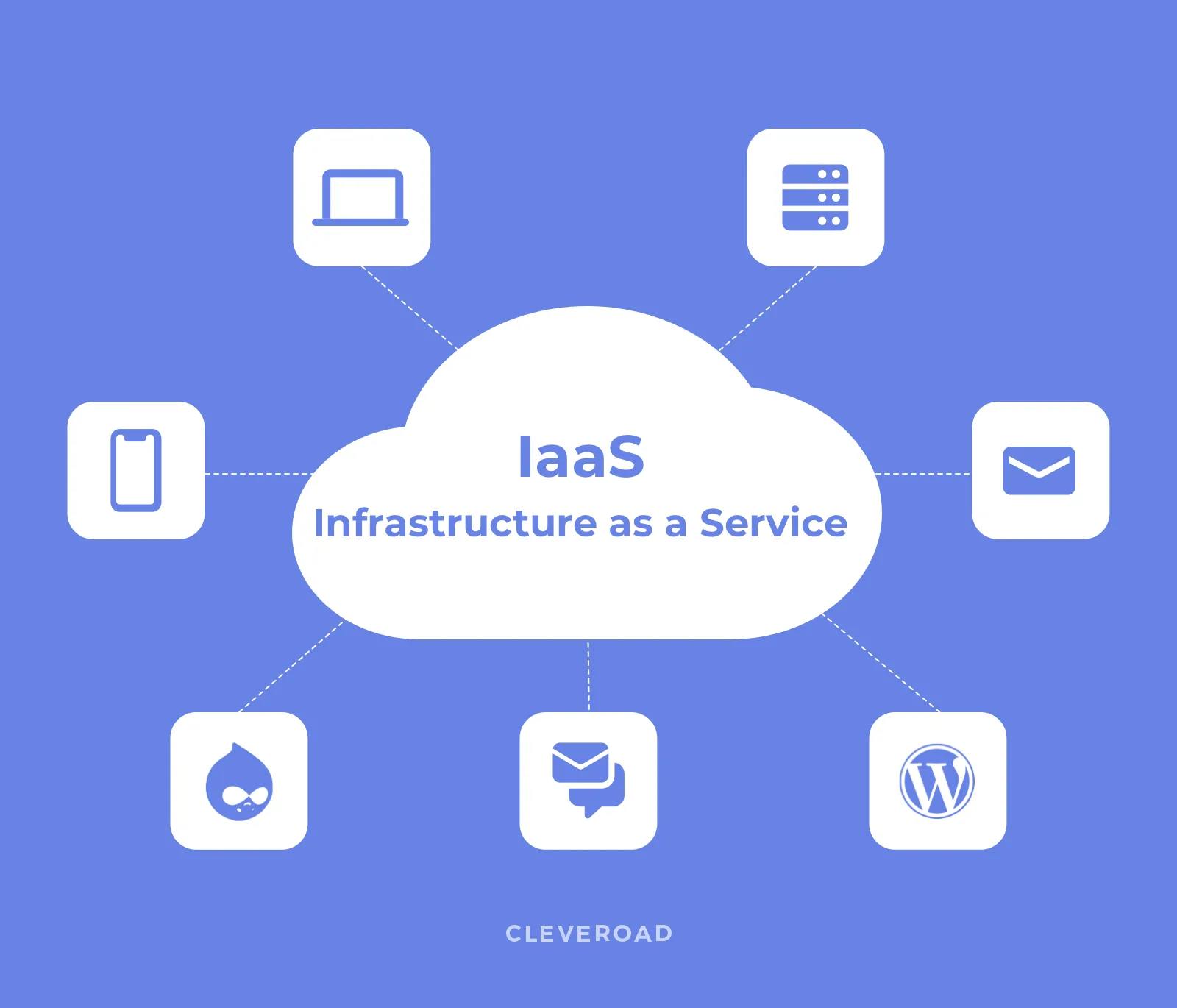What Is an IT Infrastructure? [A Beginner’s Guide]
Updated 11 Sep 2023
8 Min
6983 Views
Modern business is impossible to run without a convenient and flexible IT infrastructure. Properly set and networked, technologies can improve back-office operations, increase productivity, and make communication easier.
Information technology infrastructure or IT infrastructure refers to components required to operate and manage business IT environments. IT infrastructure can be used to deliver services or resources within an organization, or externally to organization's customers. Carefully implemented IT infrastructure helps businesses meet goals and even increase profit.
IT infrastructure offers:
- The good user experience by providing smooth access to the company’s product
- Real-time data exchange
- Increase in employees’ productivity
- Established cross-functional and interpersonal communication
- Customer satisfaction and better overall performance
What Are the IT Infrastructure Components?
IT infrastructure components stand for a combination of hardware, software, and networks. The system is designed to improve communication between components, linking devices to printers, desktops to networks, and servers to the cloud.

What is an IT infrastructure?
There are a lot of ways to deploy, organize, and integrate components of information technology infrastructure. Below you can find the components of typical IT infrastructure.
Hardware
Hardware refers to the physical components of IT infrastructure. There can be a bunch of devices from PCs to servers:
- personal computers (desktops or laptops)
- mobile devices (including tablets)
- servers
- data centers
- hubs
- routers
- switches
Software
Software stands for all the apps used by companies for internal purposes or to provide services to customers. An operating system like macOS tends to be the most important part of the software. The OS is responsible for managing system resources and hardware:
- content management systems (CMS)
- customer relationship management (CRM)
- enterprise resource planning (ERP)
- operating systems
- web servers
- any other apps
Network
Networking enables connectivity between all elements and devices to ensure Internet connectivity, firewall, and security:
- servers
- data centers
- hubs
- routers
- switches
Types of IT Infrastructure: Traditional vs. Cloud
All the components mentioned above are associated with the traditional infrastructure. This model is commonly used by enterprise companies and managed within their facilities. Put simply, those companies have data centers where they store and process information.
There is also a cloud IT infrastructure. It’s similar to the traditional model, but cloud IT infrastructure tends to be more scalable.
Traditional IT Infrastructure
The traditional IT infrastructure usually consists of hardware and software components like servers, desktop computers, enterprise software solutions, and more. Servers are typically run and installed on-premises to provide employees access to the required information and applications.
The development team requires more power and space to integrate traditional infrastructure. In most cases, traditional IT infrastructure services is more expensive to set up and support. You need to buy costly equipment and allocate resources for maintenance. The system has to be upgraded regularly to scale up data storage or other services to support more users.
Traditional IT infrastructure tends to be the most secure data hosting solution. It offers full control over your company’s apps and data.

What is traditional IT infrastructure?
When to choose traditional IT infrastructure?
- You have an in-house IT department to install and maintain hardware.
- Your company works with software development and needs to update various software solutions regularly.
- Your team runs different types of applications.
Cloud IT Infrastructure
Cloud computing gains popularity due to its convenience. What does cloud IT infrastructure mean? Instead of having physical hardware, all servers, software, and networks are hosted in the cloud.
So rather than spending money on buying physical servers in-house, you can rent the data storage from cloud computing providers like Amazon paying for it on a pay-per-use basis.
Cloud-based apps have the following characteristics:
- The app’s data is stored in a cloud infrastructure. So, there are minimum requirements for devices to run the application.
- It’s possible to store the data on the device. It allows the app to work offline. However, once the device is online again, the app will be updated automatically. As a result, all the information will be uploaded to the cloud.
- Customers can use the app from any device. All the information is stored in the cloud, so users can continue working on any device.
I’ve already touched upon cloud-based app development, covering tech-challenges and steps to take.

What is cloud IT infrastructure?
There are several differences between traditional and cloud IT infrastructure.
Scalability
Cloud hosting providers offer higher scalability in comparison to traditional IT infrastructure. Cloud computing has unlimited storage space and more server resources. It’s possible to scale up or down cloud servers, depending on your company’s requirements and business goals. Speaking about traditional IT infrastructure, you usually have limited resources, so your system can’t scale fast. The only solution is to buy or rent another server.
Automation
The key difference between cloud and traditional IT infrastructure is how they are managed. Choosing cloud hosting, you ‘delegate’ all the hardware and security issues to the service provider. However, most major cloud service vendors not always may cover all the company's security needs. Thus, it's vital to consider protection measures to eliminate possible cloud computing security risks.Traditional servers require an IT department to manage the infrastructure in-house. Of course, it takes time and money.
Costs
Cloud computing tends to be a good way of reducing IT infrastructure costs in comparison to the traditional IT architecture. Picking cloud IT infrastructure, you pay only for what you’ve actually used. Traditional IT infrastructure requires a bunch of money during the setup since you have to purchase a lot of equipment and additional server space.
A lot of cloud providers (like AWS, Microsoft Azure, DigitalOcean) are ready to give you hardware, networking, hard drives, storage, and servers.
The more data centers the provider has, the better your app performance will be. For example, global providers locate their servers to offer users the same page loading speed despite their location. It’s also a common practice to use content delivery networks (CDN) to speed up delivery. They’re often a part of cloud app infrastructure.
IT Infrastructure Management
IT organizations have already developed methodologies and frameworks for managing IT infrastructure. There are three primary practices to discuss — ITOM, ITSM, and ITAM.
IT Operational Management or ITOM
ITOM refers to the set of tools and processes that help maintain IT infrastructure. This practice also ensures that the chosen IT infrastructure is available, reliable, and effective on behalf of the business.
ITOM has various functions like network asset discovery, operational intelligence and data collection, network event management, orchestration, and cloud management.
IT Service Management or ITSM
ITSM refers to all the activities involved in designing, creating, delivering, supporting, and managing the lifecycle of IT services.
IT service management is intended to enable and maintain optimal deployment, operation, and management of every single IT resource for every user in the extended enterprise.
IT Asset Management or ITAM
ITAM is responsible for lifecycle management for IT infrastructure, both hardware and software. It usually consists of three parts:
- Financial. The primary goal of ITAM is to optimize IT expenses. It means implementing cost-effective IT infrastructure, ensuring that new investments are required and cost-justified.
- Inventory. It means that managers control and oversight IT infrastructure. As a result, it’s possible to make thoughtful decisions when investing in IT infrastructure.
- Contractual. Managers oversee software license agreements, cloud service agreements, and other contracts related to IT infrastructure.
What Is Infrastructure as a Service or IaaS?
IaaS means that a service provider manages your business's infrastructure — servers, network, visualization, and storage via a public or private cloud.
As a business owner, you can access the infrastructure using an API or admin panel. You can also manage operating systems and apps while providers (like AWS or Microsoft Azure) give you hardware, networking, hard drives, storage, and servers.
IaaS has various advantages:
- Usage-based price. You pay only for necessary and used services.
- Reduced capital expenditures. IaaS usually requires a monthly payment.
- Increased security. IaaS providers invest in security to offer better services.
- Simple access. you can access the server only by having an Internet connection.

What is Infrastructure as a Service?
How Cleveroad Can Help You
Cleveroad is a professional software development company from Central Europe. Since 2011, we've been helping businesses of all kinds implement cloud IT infrastructure.
We offer full-cycle DevOps services and help you:
- Create, adjust, support, and optimize integration and code delivery tools (Jenkins, Bamboo)
- Interact with Version Control Systems (Gitlab, Github, Bitbucket)
- Automate processes by creating scripts or using specific technologies like Ansible
- Administrate cloud platforms (AWS)
- Optimize a cloud IT infrastructure
- Integrate a required technology into a company’s IT processes
Information technology infrastructure or IT infrastructure refers to components required to operate and manage business IT environments. IT infrastructure can be used to deliver services or resources within an organization, or externally, to the organization's customers. Properly implemented IT infrastructure helps businesses meet goals and even increase profit.
IT infrastructure components stand for a combination of hardware, software, and networks. The system is designed to improve communication between components, linking devices to printers, desktops to network, and servers to the cloud.
There are two primary types of IT infrastructure — traditional and cloud.
IT organizations have already developed methodologies and frameworks for managing IT infrastructure. There are three primary practices to discuss — ITOM, ITSM, and ITAM.

Evgeniy Altynpara is a CTO and member of the Forbes Councils’ community of tech professionals. He is an expert in software development and technological entrepreneurship and has 10+years of experience in digital transformation consulting in Healthcare, FinTech, Supply Chain and Logistics
Give us your impressions about this article
Give us your impressions about this article